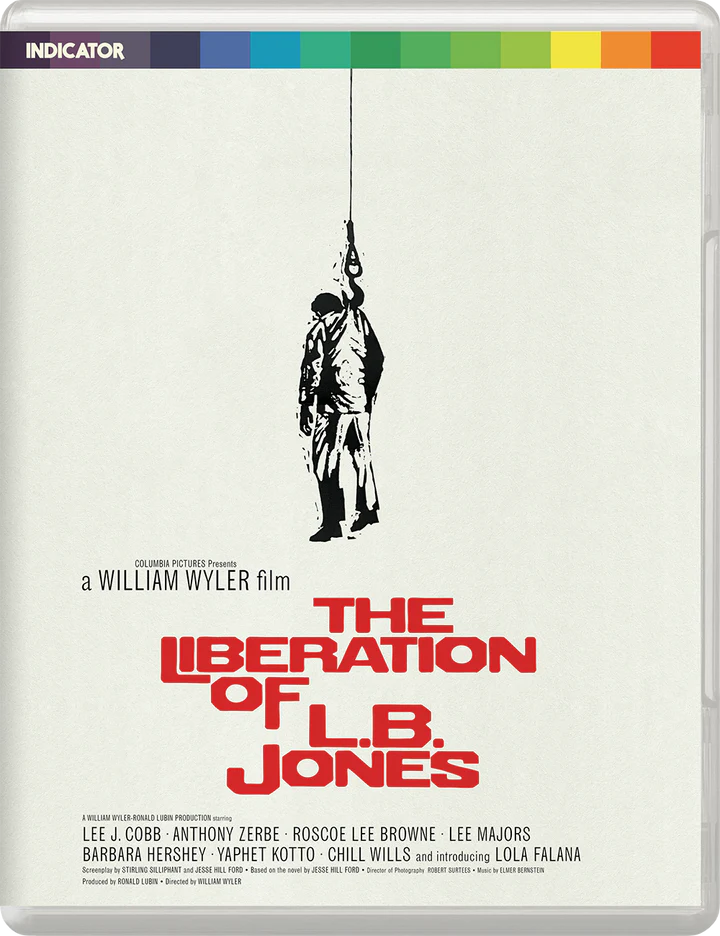|
The Film

Legendary director William Wyler (The Collector, Ben-Hur) concluded his filmmaking career with The Liberation of L.B. Jones, a searing indictment of institutional racism starring Lee J Cobb (The Dark Past), Anthony Zerbe (The Omega Man), and Roscoe Lee Browne (Cisco Pike).
When Black funeral director L B Jones (Browne) finds that his pregnant wife Emma (Lola Falana) is having an affair with white policeman Worth (Zerbe), he demands a divorce. Worth and his racist colleagues exact brutal revenge upon Jones, and conspire to cover up their actions with the assistance of the local District Attorney (Cobb)
With supporting performances from Barbara Hershey (Hannah and Her Sisters) and Yaphet Kotto (Blue Collar), and with a screenplay by Jesse Hill Ford (adapting his own novel) and Stirling Silliphant (Murphy’s War), The Liberation of L.B. Jones is a shocking tale of intolerance and injustice.
Video
Powerful, hard-hitting drama of racism in the south has superb performances across the board as its main asset and ultimately it deals very well with plenty of moral ambiguities and plays around with our feelings. From the booklet:>The Liberation of L.B. Jones was sourced from Sony’s HD remaster. The film’s original mono soundtrack was remastered at the same time. Having just covered the Powerhouse Films' disc of Bonjour Tristesse (1958) it's interesting to see the differences eleven years makes in terms of style. The Liberation of L.B. Jones (1969) was made at a point when censorship was relaxing considerably. Both are Columbia studios productions, both made by big hitting directors who were tops in their field: Otto Preminger and the William Wyler. The visual style has changed hugely with the earlier film being much more stylised. But, despite being a more realistic, low key film visually, the colour values in the 1969 film are still pretty vivid with strong primaries, just check out the reds in the early shop scene. Overall, this is a warm hued film with plenty of rich browns, tans and other earthy colours dominating all well delineated with no signs of bleed.
This is a very detailed image with an excellent balance between light and dark, shadow detail is excellent. Black levels and contrast are perfectly judged with a chiaroscuro effect, especially in the scenes when Yaphet Kotto and Zara Cully. Beautifully shot by Robert Surtees who was known for his low key work. The encode handles the grain detail with skill; the image is stable and filmic and as per no digital tools have been used. A strong transfer of a naturalistic film ('A').
1080p24 / AVC MPEG-4 / BD50 / 1.85:1 / 102:37
Audio
English LPCM 1.0 (48kHz, 24-bit)
Subtitles: English HoH
The film is well served by a standard mono track of the period with dialogue front and centre and crystal clear. Sound and music is balanced well in the mix. It's not a dynamic example of the form but it's get the job done with no distortion and only the usual mild analogue hiss occasionally evident. Hard of hearing subtitles are thorough ('B+').
Extras
Audio commentary by film historians Bryan Reesman and Mike Sargent (2025)
Two new commentators to me; they do an excellent job covering all the bases one would expect for such a racially charged and emotionally heavy film. They start with the success of the 1965 literary source, with extracts analysed and how the film changes things. The cast and crew, the themes, the bleakness of the film and how it's better regarded these days than when first released, the motivations of the characters, the racial and political issues raised by the story, how the audience either merely understands or more deeply feels the story etc are covered in depth. Presented in lossy English Dolby Digital 2.0 mono (48kHz, 192Kbps) with no subtitle options.
"Dignified Rage: Neil Sinyard on The Liberation of L. B. Jones" 2025 interview (23:55)
"Southern Injustice: Josiah Howard on The Liberation of L. B. Jones" 2025 interview (26:02)
Sinyard does his usual excellent outline of the film setting the film in context of its era how it was received and where it sits within William Wyler's own career which had been in critical decline since Ben-Hur (1959). He discusses how this last film polarised the critical fraternity and how even Charlton Heston, normally a Wyler champion, was given pause over The Liberation of L.B. Jones and how conversely, Andrew Sarris, normally a Wyler naysayer, loved it. Sinyard is always incredibly measured, listenable and interesting. Howard, who is most eloquent and learned, tracks the cinematic landscape of black cinema or black-themed cinema that led to The Liberation of L.B. Jones in this era of the Civil Rights Movement. He also looks at how the film was both exploitation (of a trend) and A-list drama, why he thinks the film failed at the box office etc. He really delves succinctly into detail circulating around this film and its reception and significance. Both pieces are presented in 1080p24 1.78:1 with uncompressed English LPCM 2.0 stereo (48kHz, 16-bit) with no subtitle options.
Isolated Music and Effects Track in LPCM (48kHz, 24-bit)
As described.
The Liberation of L. B. Jones Image Galley: Original Promotional Material (74 images)
More than adequate HD still gallery.
40-page liner notes booklet with a new essay by Fintan McDonagh, archival interviews with writer Jesse Hill Ford and actor Roscoe Lee Brown, archival production report and film credits
Powerhouse's booklets are so good they justify the price all by themselves and this one is no different.
Packaging
Not sent for review.
Overall
Golden Age of Hollywood directorial darling William Wyler's final film gets the deluxe treatment by Powerhouse Films out of the UK. Image and sound are strong and the extras are insightful and detailed. This is an excellent release and highly recommended ('A').
| The Film: B |
Video: A |
Audio: B+ |
Extras: A |
Overall: A |
|

